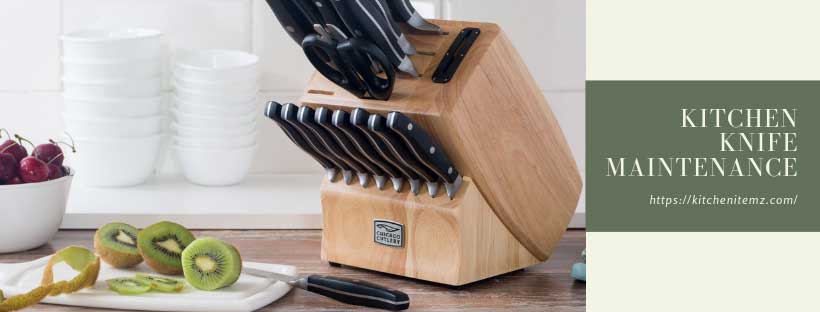
Kitchen Knife Maintenance and Cleaning Tips
Cleaning a steel blade isn’t the same to when it comes to clean a stainless Nothing gets more disturbing while cooking when you find the kitchen knife isn’t sharp and properly maintained. Although it’s a small investment, you don’t want to keep replacing your knives after a few months.
If you can take care of a few kitchen knife maintenance things, you can actually increase its lifespan and save money from buying anytime soon.
Let’s see the best ways to get the most out of your knives and enjoy quality chopping time.
First and Foremost, Not All The Blades Are The Same
Kitchen knives are made of different types of blades. Some knives have steel blades, while others have blades made of stainless steel and ceramic. Therefore, different cleaning techniques are required for different types of blades. For example, stainless steel blades are good to go with water, but this is something harmful to steel blades.
Things Before Cleaning Stainless Steel Blades
In general, stainless steel and ceramic blades last longer than carbon steel blades. However, they still need the necessary maintenance.
Maintenance of stainless steel blade is quite easy. As this material is quite rich in chrome, it doesn’t oxidize. Therefore, you are good to go to clean this type of blade with hot water along with any mild or dish soap.
Nonetheless, you should not use harsh dish soap when it comes to cleaning your stainless steel knife. Make sure you always dry the knife with a cotton rag after rinsing it with water.
If you have a forged stainless steel knife, it may lose its shine over time. However, tarnished blades tend to develop a blue, gray or yellow tint. Although it would seem the knife is oxidized, it actually protects the surface of the blade. But if you want to restore your knife’s original beauty, you need to rub it with a tool named burnisher.
To-dos Before Cleaning Ceramic Blades
Cleaning ceramic blades are also quite simple. As this material is chemically neutral, it doesn’t cause corrosion. Zirconium dioxide is used while making ceramic blades which is extremely easy to clean. When you are done with chopping veggies, simply clean the knife with running water and let the air dry it.
Considerations While Cleaning Carbon Based Steel Blades
Blades that are made of steel lack protective elements. That’s why this material easily gets rust and corrosion. But considering cutting efficiency, steel blades are very popular in the culinary world.
When it comes to cleaning a steel knife, you need to clean it with a cloth and avoid making it contact with water. However, you can clean this type of blade with a small amount of water while taking enough precautions to prevent the rust from appearing over time.
These are the things to consider while cleaning a steel knife with water –
- Don’t soak it in water
- Don’t use soap whatsoever
- If you use a damp sponge, clean it asap using a dry cloth
- Don’t dry it by leaving to the air
- Always store it in a knife block and make sure it’s dust-free
Knife Maintenance and Care Tips
When it comes to caring for your kitchen knife, there are 3 stages to consider; when you use, when you clean, and when you store it. That’s why I have divided this section into 3 categories.
Tips for Using a Kitchen Knife
- Use wooden chopping board instead of granite, marble, and other solid material, as solid materials tend to dull the blades much quicker.
- Sharpen the knife once a year. You can use an electric sharpener, sharpening stone, or send it to a professional.
- Regularly hone the blade to remove nicks and recalibrate the angle.
- When you cut something with the knife, frequently rinse it with hot water and clean to remove food from its blade. It will prevent the blade from becoming dull too soon while increasing the working efficiency.
Tips for Cleaning a Kitchen Knife
- Avoid washing the knife with a dishwasher. Elements of dishwasher dull the blade and make it discolor.
- Don’t leave the knife in a sink.
- If you wash it with hot water and mild soap, immediately hand-wash the knife or make it dry using a clean cloth to prevent corrosion, bending, and scratching.
- Don’t air dry the knife.
Tips for Storing a Kitchen Knife
- Don’t store the knife inside a drawer with other utensils. It will make the blade dull.
- Use a knife blade cover to store it inside a drawer.
- You can purchase a kitchen knife block to store all your knives in it. It’s the safest option for storing. Before purchasing, make sure the size fits your knives well.
- There are magnetic strips or racks available in the market that store knives vertically. The knives are easily accessible from such racks. However, if the blade of your knife is made of ceramic, this option isn’t for you.
Others Ways to Clean Knife
There are some natural and chemical ways to clean knives as well.
-
Using White Vinegar
You might well aware of the cleansing properties of white vinegar; but do you know you can use it to clean your kitchen knife too? Due to the cleansing properties of white vinegar, you will find this very effective to clean your knife.
Simply rub your knife’s blade with a rag or cloth soaked with heated white vinegar. When you are done, be sure to dry it using a clean cloth.
-
Using Potato
I might sound weird, but you can use a potato to clean knives as well. Potato contains starch which is very effective to make the steel rust resistant. All you need to do is cut a potato and rub the pieces of it on the blade. Make sure you rinse the knife properly and dry it.
-
Using Turpentine
If you are annoyed for having rust spots on knives from the dishwasher, I have a solution for you. You can use turpentine to remove those rust and white spots. The chemical properties of turpentine are similar to white vinegar. But don’t heat the turpentine while cleaning the knives.
-
Using Lemon
Prolonged use of a knife develops black spots on the blade. Lemon is an expert in removing such spots. Prepare a mixture of lemon juice and water of 1:5 ratio. Soak the blade into the mixture for a couple of seconds and rinse it. Then use a soft rag to dry the blade. You can repeat the process if needed.
-
Using Cork
If you use cork to clean your knife, it will restore the shine to the blade. You would require to make a cork wet using water and immerse it in the ashes of a fireplace. Then rub cork on the blade and wipe to clean it.
Final Words
Caring for your kitchen knife isn’t wasting time, rather it’s investing. You can use the knife more efficiently if the blade is properly maintained. Make sure you wisely clean your knife while considering the material of the blade.


